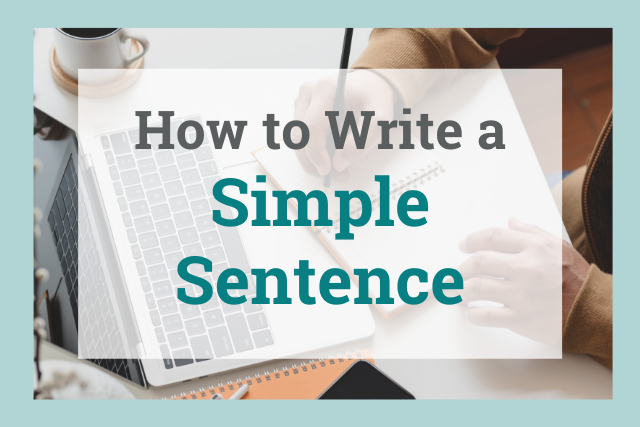
The simple sentence is the most basic sentence structure in the English language. It’s important to understand simple sentences before understanding any of the other types of sentences.
Today, we’re taking a look at the definition and parts of simple sentences and how they compare to other types of sentences. We’ll also cover the different ways that simple sentences might look when they have simple or compound subjects or verbs.
What Is a Simple Sentence?
A simple sentence is a sentence that is comprised of only one independent clause.
What’s an independent clause? Well, it’s a clause that can stand on its own as a simple sentence.
Wait a second. Do you feel like those answers are going to put us in a never-ending loop of simple sentence/independent clause definitions?
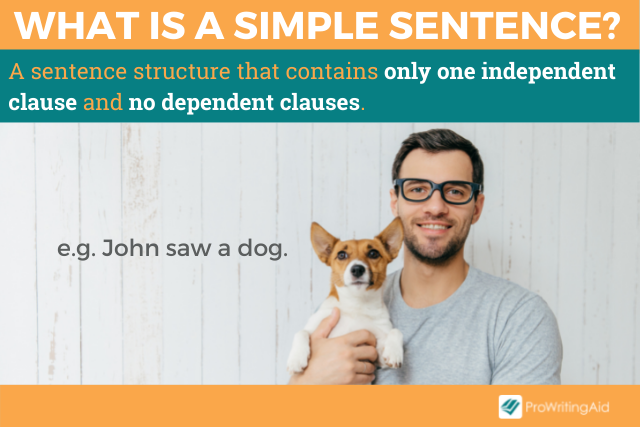
Let’s break this down. An independent clause contains a subject and a predicate. This means that a simple sentence must contain a subject and a predicate. It cannot have any other independent clauses or dependent clauses.
That’s a basic definition of simple sentence, but you might still be wondering what all those other words mean. Let’s look at simple sentences in more detail.
What Are the Parts of a Simple Sentence?
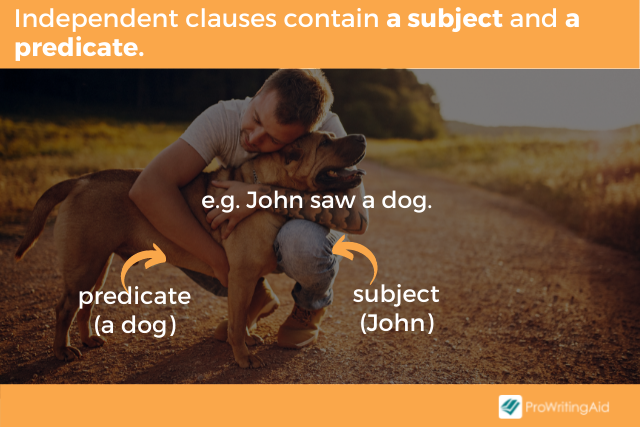
We know that a simple sentence contains a subject and a predicate. A subject is a noun, and the predicate will contain a verb or verb phrase. How do you identify the subject and predicate in a simple sentence? We’ll cover each in detail below.
How Do You Find the Subject of a Sentence?
The subject of a sentence is the person or thing that a sentence is about (the noun). It is who or what is doing the action in the sentence (the verb). If there is more than one noun in a sentence, ask yourself which one is completing the action. Here’s an example.
- John saw a dog.
John is the subject of this simple sentence. He is the one who saw the dog.
How Do You Find the Predicate in a Sentence?

The predicate is the part of a clause that contains the action done by the subject. We call this action the verb or verb phrase. It can be just one word, or several words. Let’s look at the same example.
- John saw a dog.
The predicate is "saw a dog." The verb that John does is "saw." The predicate also contains the object of the action (the dog) and all the words that don’t go with the subject. In this example, that includes "a dog."
What Are the Different Types of Simple Sentences?
Some people might tell you there are different types of simple sentences. That’s not really the case. What they probably mean is that there are different types of subjects and predicates.
This can make it look like there are four different kinds of simple sentences.
In its most basic form, a simple sentence consists of a one-word subject and a one-word predicate, like this:
- Sally eats.
There can also be an implied subject ("you"), which results in a one-word simple sentence like this imperative sentence:
- Eat!
Many simple sentences contain more than one word in their subject or predicate or both, like in our example above about John.
- John saw a dog.
- My friend John saw a dog.
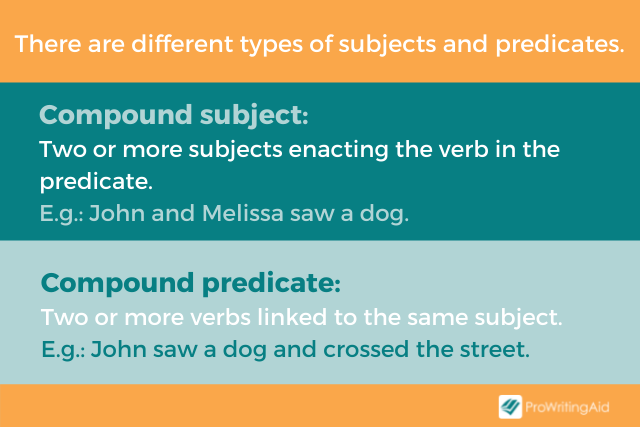
A simple sentence can also contain a compound subject. A compound subject is when there are two or more subjects doing the verb. It looks like this:
- John and Melissa saw a dog.
John is one of the subjects, and Melissa is the other. Together, they create a compound subject.
There are also compound predicates. This is when two or more verbs share a subject, but there is not a second independent clause. It might look like this:
- John saw a dog and crossed the street.
We can see that John is the subject for both "saw" and "crossed." Neither of the two predicates function as independent or dependent clauses.
A simple sentence can also have both a compound subject and a compound predicate, like in this example:
- John and Melissa saw a dog and crossed the street.
It doesn’t matter what type of subject or predicate a simple sentence has. If there is only one independent clause and no dependent clauses, then it is still a simple sentence.
What Are the Four Types of Sentences in English?
Simple sentences are just one type of sentence in English. There are actually four! They are:
- simple sentences
- compound sentences
- complex sentences
- compound-complex sentences
Let’s discover the difference between these.
What Is the Difference Between Simple Sentences and Compound Sentences?
While a simple sentence has just one independent clause, a compound sentence has two or more independent clauses.
However, neither has a dependent clause. In a compound sentence, we can combine the independent clauses in a few ways: with a comma and a conjunction, a semicolon, an em dash, or a colon.
Here’s an example of a compound sentence.
- John saw a dog, but he didn’t know what breed it was.
You see that we combined two independent clauses (John saw a dog, and He didn't know what breed it was) with a comma and the conjunction "but." We could eliminate the joining method and be left with two simple sentences:
- John saw a dog. He didn’t know what breed it was.
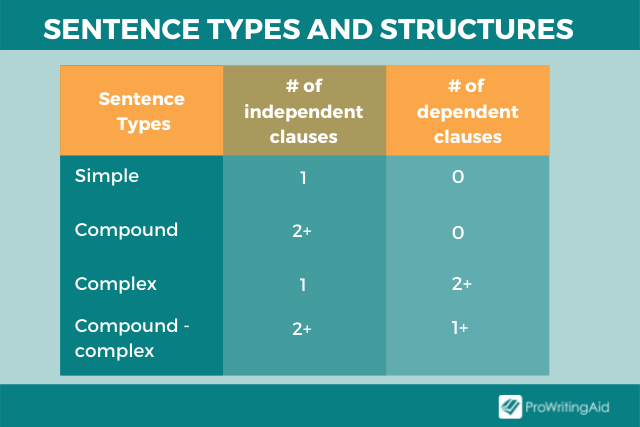
What Is the Difference Between Simple Sentences and Complex Sentences?
A complex sentence contains an independent clause and at least one dependent clause. Simple sentences do not have dependent clauses. A dependent clause cannot stand on its own as a simple sentence.
Here is an example of a complex sentence:
- While he was out running, John saw a dog.
The dependent clause is "while he was out running." That’s not a sentence by itself. It needs the independent clause to make it a complete sentence.
What Is the Difference Between Simple Sentences and Compound-Complex Sentences?
What happens when you combine a complex sentence with a compound sentence? You get a compound-complex sentence!
A compound-complex sentence contains at least two independent clauses and at least one dependent clause. This is what it looks like:
- While he was out running, John saw a dog, but he didn’t know what breed it was.
We see the dependent clause followed by two independent clauses joined with a comma and a conjunction.
These are about as far from a simple sentence as you can get. But it’s still important to understand simple sentences so that you can identify and create the other types of sentences.
It’s not a bad thing to use simple sentences. But too many of any type of sentence makes your writing hard to read. The ProWritingAid Sentence Length Report vizualizes the sentence lengths in your document so you can add variety. Too many long sentences in a row can be exhausting, while too many short sentences feel choppy and unfinished.
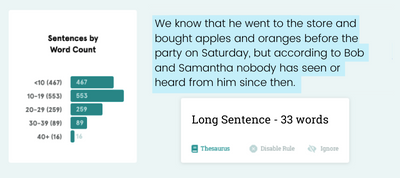
Poor sentence length variety affects both readability and pacing—check yours with a free ProWritingAid account.
What Are Some Examples of Simple Sentences?
Now that we have covered what a simple sentence is, how it might look, and how it differs from other sentence structures, let’s take a look at a few examples:
- Sally sells seashells.
- The dog is short and fat.
- Henry and Jenny ate Chinese food and watched a movie.
- We never go places or do anything fun!
- She loves you very much.
- You and I are best friends.
- Roxanne played in the snow.
- Charles Darwin sailed on board the HMS Beagle.
Now you know exactly how to write a simple sentence! Don’t be afraid to use them in your writing; just use them along with the other sentence structures.



